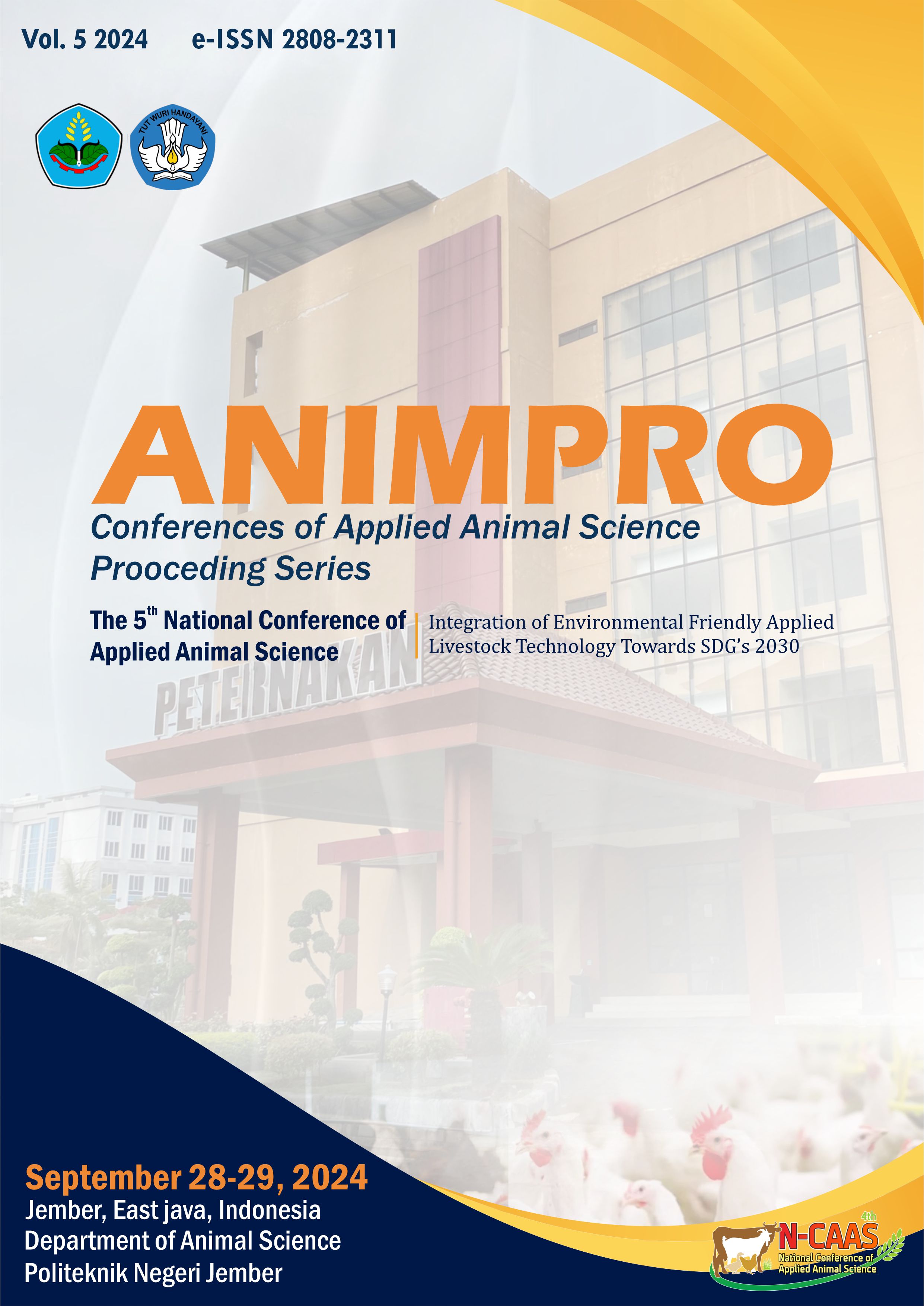Uji validasi formula pengencer spermatozoa nano- flavonoid tahan suhu ruang
DOI:
https://doi.org/10.25047/animpro.2024.726Keywords:
PO POGASI cattle, CEP, motility, nano-flavonoidsAbstract
The aim of this study was to evaluate the quality of liquid semen from POGASI cattle using CEP diluent with the addition of nano-flavonoids stored at different temperatures for 3 hours. The research material used 10 POGASI cattle, housed with an artificial vagina. The requirement for fresh cement to be used is to have progressive motility >70%. There are 3 diluent formulas, namely P0: CEP diluent; P1: CEP + nano-flavonoids 0.10 grams; and P2: CEP + nano-flavonoid 0.15 grams which was tested with fresh semen. There are 2 cement storage treatments, namely at temperatures of 3-5°C and 26-28°C. Parameters measured were sperm quality (spermatozoa motility, viability, and kinetic parameters (motility, progressive motility, pH). MDA levels, DNA Fragmentase, and SEM,. The study was repeated five times, and analyzed using analysis of variance (ANOVA). The viability of spermatozoa at a temperature of 3-5°C during the third hour of storage with the average motility level with the temporary best formulation, namely treatment P1, respectively, was (68.3±6.5; 50.0±6.7; 52.2±2.2). motility level (56.6±4.7; 55.6±6.8; 46.1±7.9). Meanwhile, storage temperature of 26°C could not support spermatozoa viability until the 3rd hour 76.3±0.7), and the motility quality of the P1 treatment did not differ much in terms of motility level, namely (78.5±1.2; 78.5±1.2). Furthermore, it can be concluded temporarily that the diluent made from CEP which added nano-flavonoids, the motility at the 2nd hour was still above 45%.
Downloads
References
Atale, N., Gupta, S., Yadav, U. C. S., & Rani, V. (2014). Cell‐death assessment by fluorescent and nonfluorescent cytosolic and nuclear staining techniques. Journal of Microscopy, 255(1), 7–19.
Kusmiyati, M., Sudaryat, Y., Lutfiah, I. A., Rustamsyah, A., & Rohdiana, D. (2015). Aktivitas antioksidan, kadar fenol total, dan flavonoid total dalam teh hijau (Camellia sinensis (L.) O. Kuntze) asal tiga perkebunan Jawa Barat. Jurnal Penelitian Teh Dan Kina, 18(2), 101–106.
Li, W., Dai, R.-J., Yu, Y.-H., Li, L., Wu, C.-M., Luan, W.-W., … Deng, Y.-L. (2007). Antihyperglycemic effect of cephalotaxus sinensis leaves and GLUT-4 translocation facilitating activity of its flavonoid constituents. Biological and Pharmaceutical Bulletin, 30(6), 1123–1129. https://doi.org/10.1248/bpb.30.1123
Mato, S. I., Nalley, W. M., Hine, T. M., & Marawali, A. (2024). Perbandingan kualitas spermatozoa babi landrace dalam pengencer dasar natrium chloride fisiologis dengan level kuning telur yang berbeda. COMSERVA: Jurnal Penelitian Dan Pengabdian Masyarakat, 4(1), 32–44. https://doi.org/https://doi.org/10.22146/jsv.352
Meseguer, M., Santiso, R., Garrido, N., García-Herrero, S., Remohí, J., & Fernandez, J. L. (2011). Effect of sperm DNA fragmentation on pregnancy outcome depends on oocyte quality. Fertility and Sterility, 95(1), 124–128. https://doi.org/10.1016/j.fertnstert.2010.05.055
Nugraheni, Z. V., Rachman, T. M., & Fadlan, A. (2022). Ekstraksi senyawa fenolat dalam daun teh hijau (Camellia sinensis). Akta Kimia Indonesia, 7(1), 69–76.
Prabowo, T. A., Bintara, S., Yusiati, L. M., Sitaresmi, P. I., & Widayati, D. T. (2023). Evaluation Deoxyribonucleic acid (DNA) fragmentation of local Indonesian cattle frozen sperm using Halomax method. Biodiversitas Journal of Biological Diversity, 24(4), 2225–2230. https://doi.org/10.13057/biodiv/d240435
Priyanto, L., Budiyanto, A., Kusumawati, A., & Kurniasih, K. (2019). Kerusakan deoxyribonucleic acid (DNA) spermatozoa memengaruhi tingkat kebuntingan Sapi Brahman. Jurnal Veteriner, 20(1), 119–124. https://doi.org/10.19087/jveteriner.2019.20.1.119
Raheja, N., Choudhary, S., Grewal, S., Sharma, N., & Kumar, N. (2018). A review on semen extenders and additives used in cattle and buffalo bull semen preservation. Journal of Entomology and Zoology Studies, 6(3), 239–245.
Raseona, A. M., Ajao, O. A., Nethengwe, L. ., Madzhie, L. ., Nedambale, T. L., & Barry, D. M. (2017). Viability of bull semen extended with commercial semen extender and two culture media stored at 24°C. South African Journal of Animal Science, 47(1), 49–55. https://doi.org/10.4314/sajas.v47i1.8
Ratnawati, D. (2017). Beberapa Parameter Motilitas Spermatozoa Semen Cair Pada Tiga Bangsa Sapi Lokal Dengan Tiga Pengencer Berbeda Selama Simpan Dingin. Universitas Brawijaya, Malang.
Rokana, E., Sayoga, Y. A., Lisnanti, E. F., & Mukmin, A. (2023). Effect of adding coconut water (Cocus viridis) on liquid semen quality of kacang goats (Capra aegagrus hircus) stored at 4-5°C. Jurnal Ilmiah Peternakan Terpadu, 11(2), 141–158.
Vladika, M. A. (2018). Pengaruh penambahan ekstrak teh hijau (Camellia sinensis) dalam bahan pengencer susu skim terhadap kualitas spermatozoa Domba Sapudi yang disimpan pada suhu dingin. Universitas Airlangga, Surabaya.
Yeste, M. (2016). Sperm cryopreservation update: Cryodamage, markers, and factors affecting the sperm freezability in pigs. Theriogenology, 85(1), 47–64.
Yin, Y., Zhu, P., Luo, T., & Xia, X. (2020). Association of single‑nucleotide polymorphisms in antioxidant genes and their gene‑gene interactions with risk of male infertility in a Chinese population. Biomedical Reports, 13(1), 49–54. https://doi.org/10.3892/br.2020.1306
Downloads
Published
How to Cite
Issue
Section
License
Copyright (c) 2024 Yeni Widyaningrum, Shobihatul Fitriya, Dicky M. Dikman

This work is licensed under a Creative Commons Attribution 4.0 International License.









